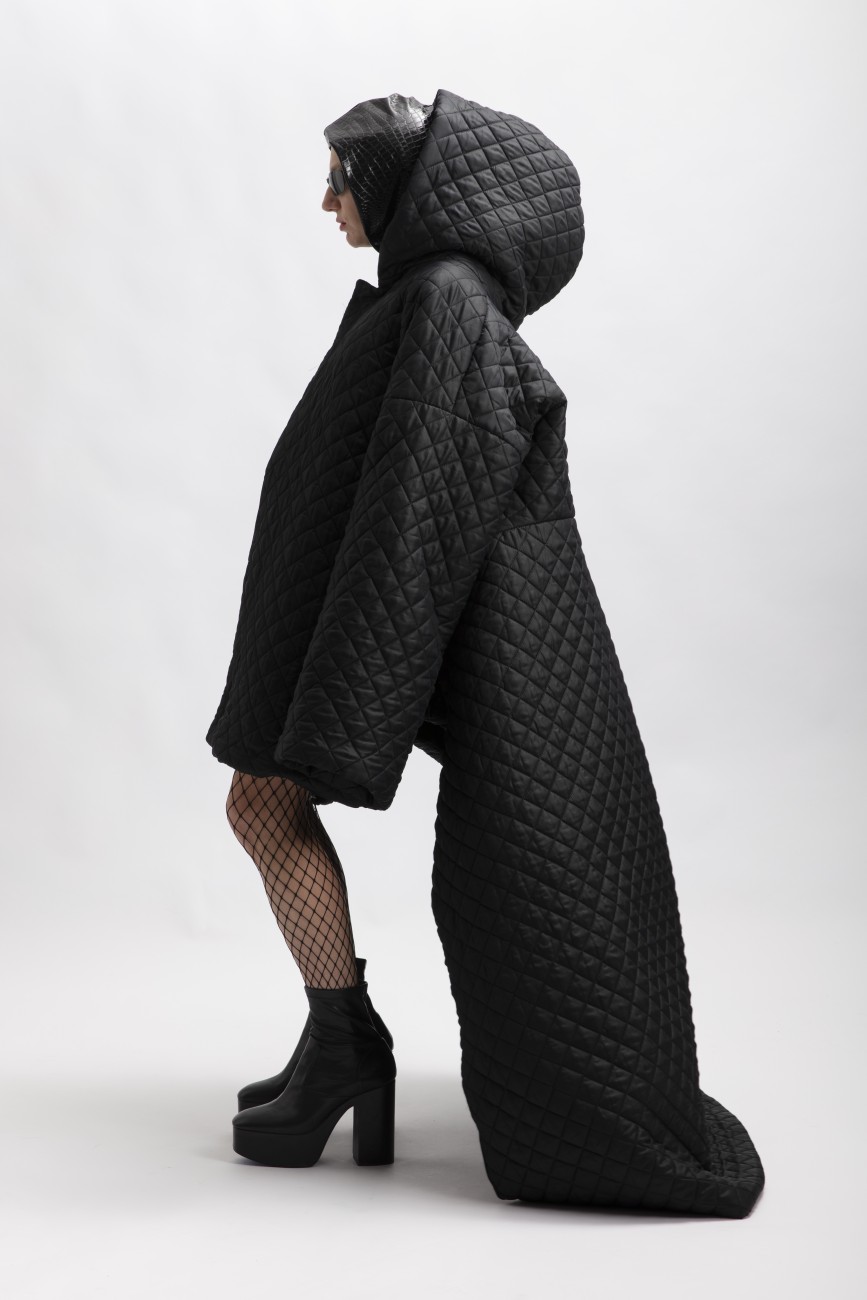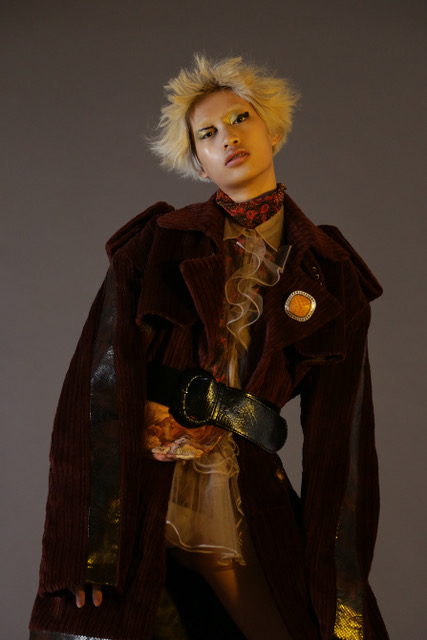From 2-4 Febraury, Milan’s little sister, Rome Fashion Week, celebrated its fortieth edition in spring sunshine, inaugurated by Silvia Venturini Fendi.
The three-day showcase, Altaroma, played host to 90 emerging brands, 11 runways, panel talks, parties and over 76,000 online spectators and guests, at Rome’s iconic Cinecittà Studios – the largest film studio in Europe.
Sustainability and diversity were top of the agenda, with over 70 percent of the labels boasting green manufacturing. Moreover, some 80 percent were projects founded or led by women.
Sandwiched between Milan’s larger fashion weeks, Altaroma draws an alternative crop of creatives – many from smaller regions of Italy. Œ went to Rome to seek out this year’s hottest underground designers.
Runway: Simon Cracker
A standout on the runway, Italian upcycling label Simon Cracker is based on free-thinking, creative interaction and collaboration.
“‘Crack’ is the fundamental concept of my brand. It means destruction: cracking something useless and giving it a new life,” explains founder and Milan-local Simone Botte.
Botte’s SS22 runway tore into conventional femininity, presenting a mashup of deconstructed wedding-dress elements blended with technical garments and traditional masculine tailoring.
 |
 |
In one look, bunches of white tulle burst from the waistline of an oversized thick-knit jumper, while another sees a billowing bridal veil stitched across the chest of a Grace Jones ‘Nightclubbing’-esque suit-jacket.
“The wedding dress is the most important garment in a woman’s life: full of meaning, story and value,” explains Botte.
“The destruction and reconstruction of these meaningful garments has led to a broader reflection on ‘the feminine’, a feeling that today is abused as a marketing strategy or a seasonal trend, while its true essence and depth is overlooked.”
 |
 |
Outwardly, Simon Cracker’s looks are brutal, with delicate bridal offcuts ruthlessly reappropriated. But the contrast breathes new life into the tulle, crinolines, lace and embroidery – which once again become fragile and decorative in their renewed form.
“While each garment is reproducible, it will never be identical,” says Botte. “Simon Cracker is based on the idea of one-of-a-kind clothing.”
Rooted in that philosophy, Botte has devised his own brand tagline: ‘punkindness’. A conceptual portmanteau of punk culture and conscious attitudes, it’s the blueprint of all his designs. “This is the true element of disruption in the times we are currently living in,” he says.
 |
 |
Images courtesy of Altaroma
Runway: Casa Preti
Bringing billowing quilted skirts to club-kid glam, Palermo-based label Casa Preti turned up to party at Rome Fashion Week.
The FW22 collection, named ‘Innocenza’, was awash with thick-soled boots, blackout shades and latex. Almost entirely black and white, looks were nonetheless spiked with flashes of fiery colour: a crimson logo here, a giant purple feather overcoat there.
 |
 |
Fun and free expression were the modus operandi, with models shelving the classic icy runway stare and half-walking, half-dancing down the strip to pounding bass.
“Casa Preti envisages a place to feel at home, with clothes characterized by clerical lines which, unchanged over time, have reached a level of truth and iconography,” explain the founders, tailor Mattia Piazza and Swiss architect Steve Gallay.
“That’s why the name merges the Italian ‘casa’ with the name of Italian Baroque-era painter Mattia Preti,” they add.

The new collection takes its cue from feelings of wonder and innocence. “It’s about an unconditioned lack of guilt and the naivety of children. Isn’t a lion innocent when it hunts a gazelle?” says Piazza.
Innocenza’s cuts are explorative. Capes, gaping sleeves and plunging necklines meet sinched-in waists, headscarves, hoods and tight-necked bibs. Exaggeration is peppered in via feathers, poufy quilting and stark, hand-drawn patterns.
In fact, Casa Preti worked with children under five to create fabric from their drawings for some of the garments. “Adults are quick to judge and voice ‘facts’ which they don’t know to be true. They apply morality to things they haven’t experienced personally,” says Piazza.
“We want a new, fresh and innocent angle to observe our times – to get to know new stories, so that every new tale can be naive.”

Showcase: Lorenzo Seghezzi
A standout of Rome Fashion Week’s brand showcase was the work of Milan-born designer Lorenzo Seghezzi. Their eponymous label melds queer history and people, underground Milanese subcultures and traditional east-African shapes.
Seghezzi’s looks include detailed corsetry, structured headwear (complete with buckles, chinstraps, fake ears and thick metal earrings), kilt-inspired skirts, waistcoats and sheer, tattoo-print tops. All the materials are second hand, except the corsets.

“Corsetry materials are very specific,” explains Seghezzi, who has a forensic passion for sartorial skills. “I try to mix different techniques and styles with my own creativity and personality to create unique designs.”Though giving a strong kink aesthetic, Seghezzi’s headwear actually draws inspiration from the fez-hats popular in Eritrea and Ethiopia.
“There’s a neighbourhood in Milan – the queer neighbourhood, which is also the east African neighbourhood. So it’s beautiful to see these two cultures which are quite separate – I mean, in many places in east Africa you can’t be homosexual – mixing in the same neighbourhood and supporting each other.”
“I tried to create a collection which is an homage to and a mix of east-African dress and aesthetic, and queer underground aesthetic – which is my own.”
 |
 |
Images courtesy of Lorenzo Seghezzi
Seghezzi’s practice of sartorial homage has garnered him a tight-knit following. Scrawled in spidery print across the chest of several designs is the slogan ‘QUEER REVOLUTION’.
“In August last year, Ava Hangar from Italy’s Drag Race asked me if she could have the phrase tattooed on her chest,” says Seghezzi. “It was surreal to see something I had handsewn in my room on a show that I’ve worshiped since I was twelve! Pure queer art is so needed in Italy right now.”
 |
 |
Images courtesy of Lars Larkin (left) and Altamoda (right)




